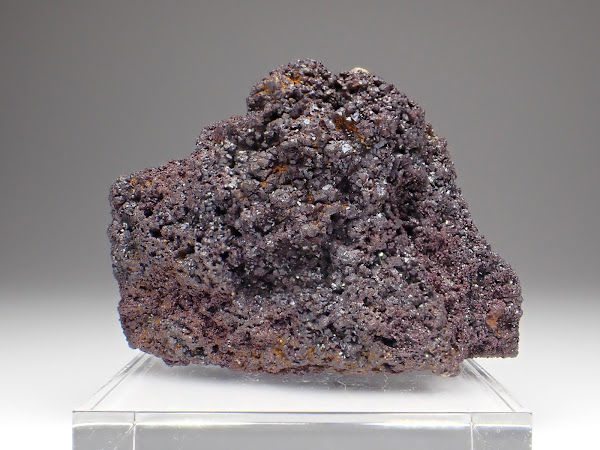荒川鉱山の赤銅鉱 Cuprite from Arakawa
Size: 59 × 43 × 30 mm / Weight: 116 g
ほぼ赤銅鉱のみからなる鉱片。結晶は径 1 mm ほどで、八面体の面と立方体の面が両方出ているもの(切頂八面体)が典型的である。表面がやや黒っぽく変色しているものの、光を当てると鮮やかな赤色を示す。鉱床浅部に自然銅が生じて、その後赤銅鉱に変化したものとおもわれるが、見たところ自然銅は存在しない。結晶サイズは小さいが、これだけのボリュームをもった赤銅鉱の標本は日本産としては貴重だろう。
荒川鉱山の銅鉱脈の酸化帯からは自然銅・赤銅鉱・孔雀石などが多産した。三浦宗次郎が明治26年(1893年)に著した論説(「荒川銅山の鉱石について」地学雑誌 5巻 5号)には、かつて百目石ヒ(ひゃくめいし;ヒは鉱脈のこと)で自然銅・赤銅鉱がたくさん採れたがすでに掘り尽くされて休業中であること、当時自然銅・赤銅鉱が採掘されていたのは荒川の主要銅鉱脈である嗽沢ヒ(うがいさわ)の通洞レベル(鉱石を外部に搬出するための主要な水平坑道のレベル)の南西端だったことが記されている。また岩崎重三が大正7年(1918年)に著した「日本鉱石学 銅篇」(内田老鶴圃)によると、荒川鉱山には当時でもまだ自然銅の鉱脈が残っていて、採掘中だったらしい。これは嗽沢(うがいさわ)ヒの南端の小支脈で、走向方向に 70 尺(21 m)、深さ方向に 20 尺(6 m)の部分の鉱石鉱物がほぼ自然銅と赤銅鉱からなっていて、相当の銅品位を誇ったという。
ドイツ・クランツ社の古いラベルがついており、いわゆる里帰り標本である。
A piece of copper ore almost purely composed of cuprite. The crystal is typically 1 mm in size and surrounded by both octahedral and cubic faces. The color is dark but turns to wine red under a strong light. There appears no native copper though cuprite is generally generated by oxidation of copper. I think this volume is quite rare as a cuprite specimen in Japan.
The Arakawa Mine had a large-scale oxidation zone from which native copper, cuprite, and malachite were produced. Miura Sojiro wrote in 1893 that a considerable amount of native copper and cuprite were once mined from the Hyakumeishi vein, and they were produced from the southwest end of the Ugaisawa vein that was the main copper source at that time. Iwasaki Juzo wrote in 1918 that there was a small vein at the south end of the Ugaisawa composed of native copper and cuprite. The vein dimension was 21 m along strike by 6 m along dip directions. He described that there remained some copper ores at that vein even at that time.
An old label of Dr. F. Krantz, Germany, came with this piece.
補記
荒川鉱山とその産出鉱物については本文掲載のものに加えて以下を参照した:
- 秋田大学鉱山絵図絵巻デジタルギャラリーの荒川鉱山の項目。鉱山の歴史がくわしく記されている。
- 進藤孝一「協和町の鉱山」(秋田文化出版、1994年)。同「荒川鉱山誌」(協和町公民館 編、1974年)。
- 「秋田県鉱山誌」(秋田県、1968年)。
- 三浦宗次郎「荒川銅山」(地学雑誌、5巻 8号、1893年)。
- 若林弥一郎「荒川鉱山付近の鉱物」(地質学雑誌、10巻 121号、1903年)。
九州大学所蔵の高壮吉標本。その他、三菱マテリアル所蔵の和田標本など、荒川の赤銅鉱は古いコレクションにはかならずといっていいほど収められている。
Cuprite from Arakawa included in the Ko Sokichi collection, Kyushu University.
荒川鉱山の周辺には宮田又、畑(はた)、亀山盛(きさもり)、日三市(ひさいち)などの諸鉱山が林立していて、江戸期から一大鉱産地帯としてしられていた。荒川鉱山は江戸中期の発見で、当時は尾改沢(おかいざわ; いまの嗽沢)、はっし沢(いまの初石沢)と呼ばれていた。明治にはいって盛岡の商人、瀬川安五郎が鉱業権を手にすると、まもなく嗽沢に大鉱脈を発見。近隣の畑鉱山などとともに盛大に稼行した。鉱床浅部を大方掘り尽くした明治29年(1896年)、瀬川は鉱業権を三菱に売却した。より先進的な技術を導入して生産性をあげるのが国益にかなうと考えたようだ。三菱の資本がはいるとすぐに発電所を設けて鉱山設備を電化するなど、近代的な開発・経営がおこなわれた。鉱石鉱物は黄銅鉱を主とし、その他の金属鉱物は少なかった。昭和5年(1930年)頃から鉱況が悪化し、昭和15年(1940年)休山。その後は沈殿銅の生産が細々とおこなわれたようである。
The area around the Arakawa Mine has been known as a large-scale ore field since the Edo period (17th century), where metal mines such as Miyatamata, Hata, Kisamori, and Hisaichi existed. Arakawa was found in the Mid Edo period (18th century). The early mining places were Okai-sawa (= Ugai-sawa) and Hasshi-sawa (Hatsuishi-sawa). Soon after Segawa Yasugoro acquired the mining right at the beginning of the Meiji period (late 19th century), he found a big copper vein at Ugaisawa. He also managed the Hata and some neighboring mines near Arakawa. Mining the shallower part of the ore deposits, he sold the mines to Mitsubishi Company in 1896. Mitsubishi soon built an electric power plant and modernized the mining and smelting facilities. The ore mineral was mainly chalcopyrite, and other metal minerals were not common. The ore production gradually decreased in 1930 and the mine was closed in 1940.
江戸初期の文献に「荒川銀山」の名があるが、これはいまの畑鉱山周辺の旧坑を指すのではないかというのが通説である。
瀬川安五郎と荒川鉱山の関係については「荒川鉱山誌」や渡辺万次郎「鉱山史話 東北編」(丸善、1968年)に記述がある。盛岡の両替商に生まれ、生糸取引で財をなし、第四十八国立銀行(のちの秋田銀行)の創立に携わるなど、東北財界の重鎮だった。明治14年(1881年)の天皇東北巡幸の際には秋田市内の瀬川邸が行在所(あんざいしょ; 天皇の旅行中の仮の御殿)となった。荒川をはじめとする鉱山の経営については景気にも左右されて必ずしも順風満帆ではなかったようだが、鉱山の規模の割には従業員を多く抱えたなど、義理人情に篤い人物と語られることが多い。秋田の鉱産資源は富国強兵の名目のもと政府と密接な関係にあった中央財閥の手に渡り、地元民は結局のところ搾取されただけだったのではないか、との疑念がぬぐえないが、明治前期の荒川鉱山は地元財界が奮闘した稀有な例ではなかったかとおもわれる。




